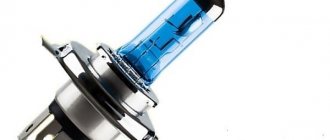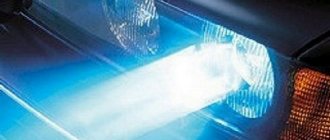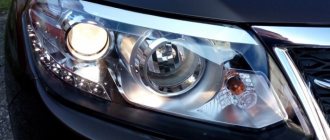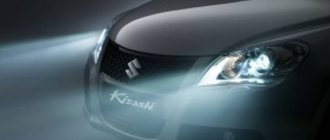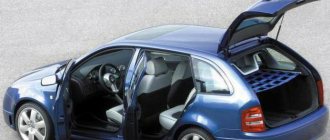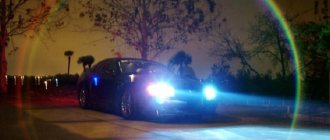What is xenon, why is it installed?
Xenon is the common name for gas-discharge lamps in which an electric arc glows in a bulb filled with gas - xenon.
This source produces bright white light, close to daylight. Xenon lamps do not have a filament like halogen lamps. An electric arc occurs between two electrodes. To ignite the arc, it is necessary to generate high-voltage (up to 25,000 V) voltage pulses. Therefore, to “ignite” such a lamp, a special control unit is used, which increases the voltage when the headlights with xenon lamps are turned on. After the lamp is lit, a nominal voltage of up to 80 V is sufficient to maintain the discharge.
Rules for installing bi-xenon lenses in 2018
Bi-xenon lenses have become widespread and are quite popular among car enthusiasts, but at the same time, the legality of a significant part of them is in question. Why does this happen, what are these headlights in general and what is the responsibility for installing them? We will try to understand these issues in this article.
What it is?
As you can easily guess from the name, bi-xenon lenses are an improved version of regular xenon. One of the main disadvantages of HID lamps is that they only provide low beam, while standard halogen headlights are used for high beam.
Bi-xenon bulbs, in turn, can emit both types of light (due to the presence of a special curtain or toggle switch), which is their main advantage. This is what explains the prefix “bi” in the name of the equipment, which indicates the presence of two functions at once.
At the same time, this type of lens retains all the advantages of the xenon analogue, namely:
- long service life (several times longer than halogen);
- bright lighting at night (allows the driver to detect obstacles on the roads much earlier);
- low glass heating (which is especially useful if you often have to deal with temperature changes) and dirtiness of the headlights.
For all these advantages, potential owners will have to fork out a lot, and also tinker a lot with installing light bulbs on the car.
Is bi-xenon allowed for installation?
Formally, use is not prohibited, but you won’t be able to simply install this type of lens on your car yourself - there are certain conditions under which the use of headlights will be considered legal. We are talking about the following situations:
- Bi-xenon-based lighting devices are initially provided by the manufacturer and are part of the factory design of the vehicle;
- The car was re-equipped to install gas-discharge lamps, all required tests were passed, certification, a certificate of conformity and a new vehicle passport were obtained;
- Bi-xenon lenses were purchased from the official manufacturer of the car, which has all the necessary documentation (confirmation of compliance with all GOST standards).
Otherwise, installing headlights will be considered an offense, which threatens the driver with serious consequences. The logic of the regulatory agencies here is quite clear and easy to explain - self-inserted xenon is very rarely adjusted normally, which is why it becomes quite dangerous. The main problems they include:
- Greater risk of fire. Gas-discharge lamps are a high-voltage source, so their installation in a vehicle not intended for this purpose can lead to malfunction and even fire;
- Reduced visibility for drivers of oncoming cars. We are talking here specifically about homemade xenon (popularly also called collective farm xenon), that is, about lighting devices installed in a vehicle of an inappropriate design.
Can it be legalized?
As mentioned above, there is a legal way to operate bi-xenon lenses. In the most ideal version, the factory equipment of the car initially provides for the possibility of using such optics (this fact should be confirmed by notes in the technical passport and technical inspection of the car). In this case, nothing additional needs to be done. If the vehicle initially does not meet the stated requirement, then it can be modified specifically to be equipped with gas-discharge headlights. The procedure is as follows:
- The owner of the car draws up an application for vehicle conversion, which, in fact, indicates the intention to install a bi-xenon module instead of standard halogen lamps;
- The application is submitted to the traffic police department at the place of residence, whose employees draw up the appropriate resolution;
- Next, a certain package of documents (application from the traffic police with a resolution, PTS, vehicle registration certificate, detailed description of the planned work, certification for bi-xenon lenses) is sent to NAMI-PTIA-FOND (an organization that registers the fact of vehicle conversion).
- Within a couple of days, the owner receives a response - “Conclusion on the possibility of making changes...”. Next, the service center carries out all the necessary work to install new headlights, which is confirmed by a document (“Application-Declaration ...”).
- Equipped lenses are checked for compliance with regulatory requirements at the SGTO or VET, as a result of which the owner of the car receives a diagnostic card and a “certificate of compliance...”.
- The traffic police reissues documents for the vehicle (PTS and registration certificate), and then special notes are made on them about the installed bi-xenon modules.
What are the risks of using lenses without permission?
From the point of view of current norms and regulations, bi-xenon lenses are no different from conventional xenon lenses, and therefore the situation with punishing drivers for their illegal installation is similar. You can read about the use of xenon in headlights in the article at the link.
The essence of this situation is as follows: traffic police officers make full use of Article 12.5 of the Administrative Code, the main sanction for which is deprivation of rights for a period of 6 to 12 months. At the same time, the first time the culprit will probably be forgiven and limited to a fine (for this violation this is a maximum of 500 rubles), strongly recommending either changing the type of headlights used, or registering them in the manner prescribed by law. Ignoring comments will result in much more serious sanctions, up to and including actual deprivation of rights.
Conclusion
The use of bi-xenon lenses in car headlights is considered a violation of the vehicle operating rules. The car owner may face punishment in the form of a fine or deprivation of his license for illegal installation. However, permission to use such lenses can be obtained by going through a certain procedure with re-registration of documents for the car.
Source: https://insur-portal.ru/shtrafy/vybor-i-ustanovka-biksenona
Which headlights can xenon be installed in?
On February 20, 2010, the Road Safety Department of the Ministry of Internal Affairs of Russia gave an explanation “On the use of xenon headlights” (full text of the letter here).
Currently, the following officially approved types of headlights are installed on vehicles:
- C - low beam, R - high beam, CR - dual-mode (low and high beam) light with incandescent lamps (UNECE Rules No. 112, GOST R 41.112-2005);
— HC — low beam, HR — high beam, HCR — dual-mode light with halogen incandescent lamps (UNECE Rules N 112, GOST R 41.112-2005);
— DC — low beam, DR — high beam, DCR — dual-mode light with gas-discharge light sources (UNECE Rules N 98, GOST R 41.98-99).
An appropriate marking indicating the type of headlamp (exterior light fixture) and the approval mark (consisting of a circle containing the letter “E” followed by the number of the country which has granted approval and the approval number) is affixed to the lens of the headlamp and on the headlamp housing, if the lens can be separated from it.
The category designation for halogen incandescent lamps, shown on their base or bulb, begins with the letter “H”.
Gas-discharge light sources, the category marking of which, indicated on the base, begins with the letter “D”, in accordance with the requirements of UNECE Regulation No. 99 and GOST R 41.99-99 “Uniform provisions concerning the official approval of gas-discharge light sources for use in officially approved gas-discharge optical elements of motor vehicles" are intended for use only in headlights of DC, DR, DCR types.
Therefore, xenon lamps can only be installed in headlights marked DR, DC, DCR. If you have installed gas-discharge lamps in a headlight marked HR, NS, HCR, then you will not be able to persuade a traffic police officer to give a verbal warning if he notices a violation.
Technical requirements
The installation of xenon is not completely prohibited; in order to use this type of optics, you need to follow a number of rules. First of all, you should pay attention to the headlight markings.
Main headlight markings that allow xenon installation:
- DC/DR - this marking provides information that the headlights are equipped with separate compartments for low and high beam. It is permissible to install xenon in any compartment.
- DCR means that the optics are equipped with a single lamp for high and low beam. Such headlights are called dual-mode. Installation of xenon is allowed.
- DC/HR - if your headlights have similar markings, then you can only install xenon in the high beam compartment.
- HC/HR - such optics are installed on Japanese-made cars. You can install xenon. But there is one caveat: cars from Europe may come with the same marking, in this case it means that xenon cannot be installed.
Attention! To avoid being fined for installing xenon, you need to insert a separate unit into the headlight, which consists of a reflector, lens and lamp connector. This installation will allow you to achieve a light flow that meets the requirements of GOST.
In addition, xenon optics are necessarily equipped with high-pressure windshield washers.
Why was the installation of xenon banned?
The above document provides explanations from the Federal State Unitary Enterprise “Research and Experimental Institute of Automotive Electronics and Electrical Equipment”, according to which the use of light sources in external lighting devices that do not correspond to the type of the given lighting device violates the conditions for ensuring road safety due to a number of physical factors (dimensions of the spark discharge, wavelength, scattering angle of reflected radiation) and technical (class of reflective surface of the reflector, presence on the vehicle of an automatic light beam corrector and headlight washer) factors.
Thus, the use of gas-discharge light sources in headlights intended for use with incandescent lamps, including halogen lamps, is not permissible.
How to make xenon legal
Until 2014, every car owner had the opportunity to officially convert their vehicle by going through many checks and procedures. Order of the Ministry of Internal Affairs No. 1123 of December 22, 2014 canceled a number of decisions, including the possibility of legalizing a number of changes in the design of a car. This led to many administrative cases, fines and withdrawal of rights.
Today, it is possible to install xenon in a car if two conditions are met:
- there is a DCR, DC or DR mark;
- A headlight washer and automatic leveling are provided.
Failure to comply with these conditions leads to an automatic ban on installing xenon in vehicle lighting fixtures. As well as fines and other administrative penalties.
To legalize xenon, you must first undergo an examination at NAMI (Research Institute that certifies automobile products). To do this, you need to write an application and pay for the service - 4000 rubles.
After an interim expert assessment, they submit an application to the traffic police, where they register all the details of the vehicle and its owner.
The following is a package of documents:
- preliminary conclusion by NAMI;
- PTS;
- vehicle registration certificate;
- car owner's passport.
Then you will need to purchase and install new equipment on the vehicle. The final stage is a technical inspection and a full conclusion that the lighting devices meet the technical requirements. The driver now faces no fines or other sanctions.
Punishment for non-standard xenon until 2021
There is no direct ban in the administrative code on xenon lamps in conventional headlights. Until 2021, for driving a vehicle with such headlights, traffic police officers qualified under Part 3 of Article 12.5 of the Code of Administrative Offenses of the Russian Federation :
Driving a vehicle on the front of which are installed lighting devices with red lights or red reflective devices, as well as lighting devices, the color of the lights and the mode of operation of which do not comply with the requirements of the Basic Regulations for the admission of vehicles to operation and the duties of safety officials traffic, -
entails deprivation of the right to drive vehicles for a period of 6 months. up to 1 year with confiscation of the specified instruments and devices.
What requirements of the main provisions are discussed in the law?
The appendix to the Traffic Rules contains a list of malfunctions and conditions when operating the vehicle is prohibited. These include cases where the number, type, color, location and operating mode of external lighting devices do not meet the requirements of the vehicle design. And also: when the headlights use lenses and lamps that do not correspond to the type of the given lighting device.
Thus, traffic police officers, in order to bring the driver to administrative responsibility, removed the ignition unit with a xenon lamp installed in the headlight and recorded markings on the headlight, which indicate that only a halogen lamp can be installed in it.
Similar cases were considered by magistrates' courts. Most of the reviews ended in deprivation of the right to drive.
Xenon in fog lighting devices
According to the regulations, fog lights are also recognized as lighting devices, so they are subject to similar requirements. For installing unspecified xenon lighting devices, the driver will also be deprived of his license.
Just as with headlights, liability will only arise if the markings on the headlights and lamps do not match.
GOST establishes the following types of xenon headlights:
- DC – designed for short-distance illumination;
- DR – long distance lighting;
- DCR – any distance.
The designation without the letter D means that the use of xenon is not intended, so you should always check the information carefully.
Fine for xenon in 2021
In 2021, the Plenum of the Supreme Court of the Russian Federation issued a resolution (dated June 25, 2019 No. 20), which clarified the issues of applying administrative legislation in the event of detection of illegally installed xenon in car headlights. Namely:
The objective side of the offense provided for in Part 3 of Article 12.5 of the Code of Administrative Offenses of the Russian Federation can only occur in the event of a simultaneous discrepancy between the color of the lights and the operating mode of such devices with the requirements specified by the vehicle manufacturer in the operational documentation.
If only the color or operating mode of the light devices installed on the vehicle does not comply with the above requirements, driving such a vehicle may be qualified under Part 1 of Article 12.5 of the Code of Administrative Offenses of the Russian Federation.
Thus, the wording of the law has not changed as a result. Its interpretation has changed. Currently, installing xenon in headlights not designed for this type of lamp is considered a modification to the design of the vehicle.
If a traffic police officer detects such a violation, he will issue a fine under Part 1 of Article 12.5 of the Code of Administrative Offenses of the Russian Federation, for which a fine of 500 rubles is provided. However, that's not all. Along with the fine, the inspector will demand that the violation be eliminated and set a period of 10 days for this. If the violation is not eliminated, the registration of the vehicle will be terminated.
Ask a Question
Here you can refer to the topic of the article or request assistance in appealing the fine
Don't miss new useful publications
We will tell you about the intricacies of the legislation, help you understand it and tell you what to do in controversial situations.
Confiscation of xenon lamps in case of violation
Clause 3 of Article 12.5 of the Code of Administrative Offenses clearly states that for xenon in the PTF or other headlights in front of the car, a fine is imposed - deprivation of rights with confiscation.
That is, dismantling a xenon headlight at a vehicle stop is absolutely legal. Another thing is that the inspector is obliged to seize the lighting device by law, in compliance with all the rules. The driver can appeal in court not only the confiscation, but also the deprivation of his license. If the court's decision is positive, the driver's license will be returned. But it is quite possible that he will not avoid a fine.
Technical features and nuances of using xenon lamps
Xenon or conventional halogen lamps can be installed in the front lighting fixtures of the car. Of course, the second option is standard and applies to most vehicles. However, xenon also has its admirers. Car owners explain the installation of xenon lamps by their efficiency, increased brightness and long service life.
On the one hand, xenon allows the driver to get maximum visibility of the roadway at night, but at the same time, such headlights strongly blind other drivers, which often leads to accidents. The main problem is that the light beam is not only overly intense, but also directed in the wrong direction.
According to traffic police officers, the blinding properties of xenon are due to the fact that the correct use of such lamps involves the installation of appropriate headlights. In particular, we are talking about reflective and scattering elements, which in their characteristics differ significantly from halogen ones. In other words, if you install xenon lamps in halogen headlights, this will cause a glare effect.
Unauthorized installation of xenon headlights or lamps, if not provided by the manufacturer, is illegal and punishable by a fine. To avoid unpleasant consequences, experts strongly recommend carefully studying all the characteristics and capabilities of the vehicle, as well as comparing the markings on the reflectors and the lamps themselves. According to current standards, both elements must be marked with the letter D.
Representatives of the traffic police also argue that installation of lighting fixtures should be carried out by professionals. Only having the appropriate knowledge and experience will allow the installation to be carried out in full accordance with the technical requirements.
Every car owner should know that directly during a stop, a traffic police officer will not be able to check the compliance of the lighting equipment, which is explained by the lack of necessary equipment and knowledge in general.
The car can be sent to the nearest stationary post, where the appropriate check will be carried out. If the inspection reveals violations, the driver will be issued a fine.
Features of payment of a fine and the procedure for appealing it
If the driver has been issued a fine for illegal use of xenon, then payment should be made as soon as possible. The maximum period for payment of collection is 60 days. If a difficult financial situation does not allow the car owner to repay the entire amount in a timely manner, he must submit a corresponding application to the traffic police.
If there is evidence confirming a difficult financial situation, the offender may be granted a deferment. Among other things, today there are some benefits that include a discount of 50% of the fine. Such leniency can only be counted on in the following cases:
- The violation is minor;
- The car owner wishes to pay off the fine within 20 days after receiving the decision.
Those who consider the actions of the traffic police officers to be illegal and the fine to be unreasonable will have to resolve the problem through the courts. The corresponding complaint can be filed within 10 days after receiving the decision. This document should be drawn up in strict accordance with the norms and requirements of the Code of Civil Procedure, supported by references to current legislation.
When is a driver's license revoked for xenon?
Xenon lamps that have been installed in violation of the requirements create many problems for road users. They create a bright light that is directed not only at the road, but also at oncoming cars. As practice shows, the actual illumination of the road is worse than when using standard lamps.
Attention! If you have any questions, you can chat for free with a lawyer at the bottom of the screen or call Moscow; Saint Petersburg; Free call for all of Russia.
In addition, there are a number of reasons why unauthorized installation of xenon is prohibited and threatens deprivation of rights:
• Drivers of both oncoming and passing vehicles may be temporarily blinded by bright lights; • Incorrectly mounted reflectors may direct the light upward; • Extra shadows may appear, which disrupt the objective perception of what is happening on the road; • Insufficient road illumination at long distances.
There is no penalty for installing xenon lamps, but their use may contradict traffic regulations. Such a car may be considered technically faulty, and the driver may be subject to license deprivation for 6-12 months.
Traffic regulations provide a list of malfunctions of lighting devices, in the presence of which the operation of the vehicle is prohibited: • Installed devices are not provided for by the manufacturer's design, including main headlights and fog lights; • Adjustment of headlights used in a car does not comply with GOST; • Reflectors, lamps or lenses do not match the type of headlights.
If xenon lamps are included in the design of the vehicle, they should not cause any problems on the road, so the driver of such a car does not have to fear fines or deprivation of his license for xenon.
